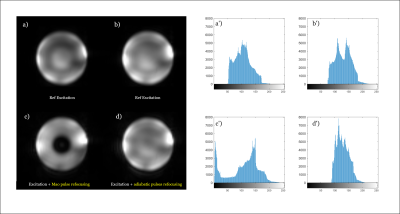Guodong Weng1, Sulaiman Sheriff2, Claus Kiefer1, Irena Zubak3, Andrew A Maudsley2, and Johannes Slotboom1
1Institute for Diagnostic and Interventional Neuroradiology, Support Center for Advanced Neuroimaging (SCAN), University of Bern, Bern, Switzerland, 2Department of Radiology, University of Miami School of Medicine, Miami, FL, United States, 3Inselspital Bern and University Hospital, Bern, Switzerland
1Institute for Diagnostic and Interventional Neuroradiology, Support Center for Advanced Neuroimaging (SCAN), University of Bern, Bern, Switzerland, 2Department of Radiology, University of Miami School of Medicine, Miami, FL, United States, 3Inselspital Bern and University Hospital, Bern, Switzerland
A whole brain EPSI-variant sequence is developed in this study. The results show a 77% reduction of CSDA, homogeneous refocusing map, water suppression factor ≥ 1000 within 8 minutes as well as an acceptable SAR both in vitro and in vivo measurement.

Figure1: (a.)
EPSI pulse sequence using spatial selective amplitude modulated excitation and
refocusing RF-pulses. (b.) Proposed EPSI variant of this abstract: the slice
selective Mao pulse typed refocusing pulse is replaced by a chemical shift
selective adiabatic complex hyperbolic-secant 2π-pulse pair. All the measurements
were performed with a volume of interest of 280 X 220 X 100 mm.

Figure 2: (a-d) water maps: comparison of non-adiabatic excitation
and refocusing using Mao pulses (a,c) with complex hyperbolic secant RF-pulses
(b,d). (a’-d’) corresponding histograms of the images (a-d) over the phantom
area. TE
= 82 ms, TR = 1500 ms, BW = 1.4 kHz with a resolution of 4.3 X 11 X 13.8 mm.
